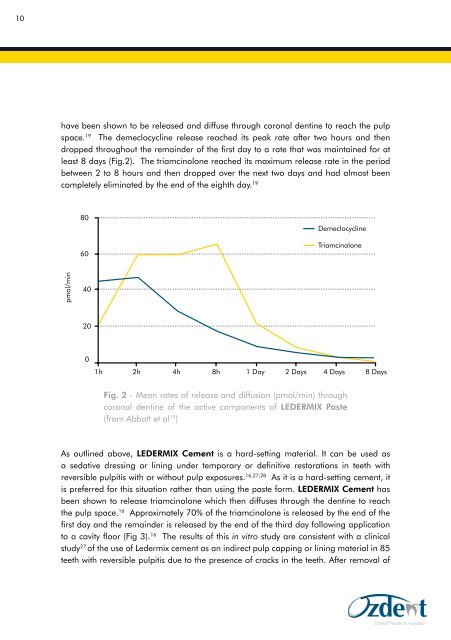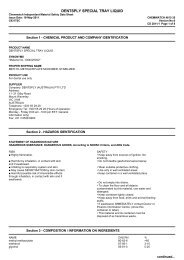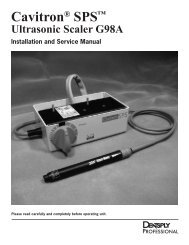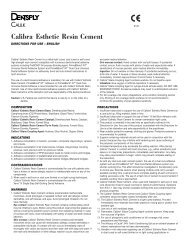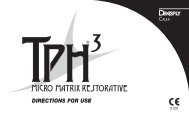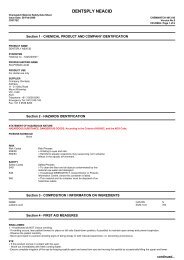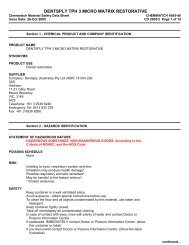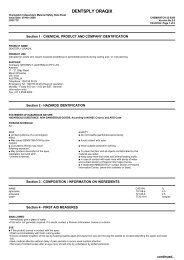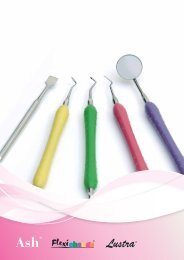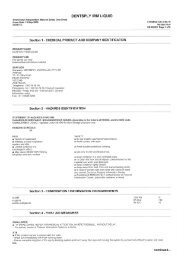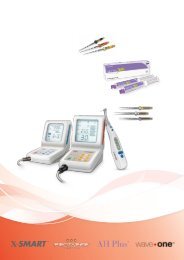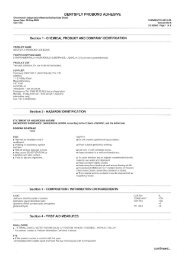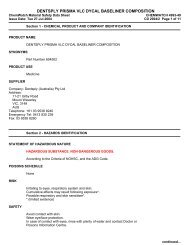The Materials - Dentsply
The Materials - Dentsply
The Materials - Dentsply
You also want an ePaper? Increase the reach of your titles
YUMPU automatically turns print PDFs into web optimized ePapers that Google loves.
10 11<br />
<strong>The</strong><br />
<strong>Materials</strong><br />
have been shown to be released and diffuse through coronal dentine to reach the pulp<br />
space. 19 <strong>The</strong> demeclocycline release reached its peak rate after two hours and then<br />
dropped throughout the remainder of the first day to a rate that was maintained for at<br />
least 8 days (Fig.2). <strong>The</strong> triamcinolone reached its maximum release rate in the period<br />
between 2 to 8 hours and then dropped over the next two days and had almost been<br />
completely eliminated by the end of the eighth day. 19<br />
the crack and caries followed by the placement of Ledermix cement and an interim glass<br />
ionomer restoration, complete resolution of symptoms occurred immediately in 71% of<br />
the patients. A further 21% of cases had resolution of the symptoms within 1 day, 6% took<br />
2 days and 3% took 3 days. On follow-up after three months, 98% of the teeth showed<br />
signs of the pulpitis having completely resolved and the pulps had returned to a clinically<br />
normal state (Fig 4). 27<br />
80<br />
Demeclocycline<br />
100<br />
A B C<br />
pmol/min<br />
60<br />
40<br />
Triamcinolone<br />
Percent of Release<br />
75<br />
50<br />
20<br />
25<br />
Control<br />
0<br />
1h 2h 4h 8h 1 Day 2 Days 4 Days 8 Days<br />
0<br />
1h 4h 24h 2 Days 28 Days<br />
Fig. 2 - Mean rates of release and diffusion (pmol/min) through<br />
coronal dentine of the active components of LEDERMIX Paste<br />
(from Abbott et al 19 )<br />
Fig. 3 - Percentage release and diffusion through coronal dentine<br />
of triamcinolone from Ledermix Cement in three experimental<br />
teeth (A, B, C) and one control tooth (with no Ledermix cement)<br />
(Adapted from Hume & Kenney 16 )<br />
As outlined above, LEDERMIX Cement is a hard-setting material. It can be used as<br />
a sedative dressing or lining under temporary or definitive restorations in teeth with<br />
reversible pulpitis with or without pulp exposures. 16,27,28 As it is a hard-setting cement, it<br />
is preferred for this situation rather than using the paste form. LEDERMIX Cement has<br />
been shown to release triamcinolone which then diffuses through the dentine to reach<br />
the pulp space. 16 Approximately 70% of the triamcinolone is released by the end of the<br />
first day and the remainder is released by the end of the third day following application<br />
to a cavity floor (Fig 3). 16 <strong>The</strong> results of this in vitro study are consistent with a clinical<br />
study 27 of the use of Ledermix cement as an indirect pulp capping or lining material in 85<br />
teeth with reversible pulpitis due to the presence of cracks in the teeth. After removal of<br />
After the triamcinolone is released from LEDERMIX Cement, the remaining cement<br />
is essentially a zinc oxide-eugenol material with calcium hydroxide. Both of these<br />
components have well known and researched therapeutic effects on the pulp. Calcium<br />
hydroxide has beneficial effects on the healing of dental pulps and the formation of<br />
reactionary/reparative dentine 30,31 whilst the eugenol can be both anti-inflammatory and<br />
anti-bacterial, 32-34 depending on the concentration reaching the dentine and pulp as it is<br />
released by progressive hydrolysis occurring at the cavity floor.


